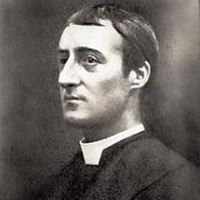The Windhover by Gerard Manley Hopkins: Summary and Analysis
The Windhover by Gerard Manley Hopkins is a semi-romantic, religious poem dedicated to Christ. It is a usual Hopkinsian sonnet that begins with description of nature and ends in meditation about God and Christ and his beauty, greatness and grace. The poem also uses his usual “sprung rhythm”, Anglo-Saxon diction, alliteration, internal rhyming, new compound metaphors, elliptical grammar and complex threads of connotation.

Gerard M. Hopkins (1844-1889)
Hopkins has mixed his romantic fascination with the nature with his religious favor of gratitude towards God for giving us a beautiful nature. The beauty of nature is here illustrated by a wonderful bird flying in the air. He describes a bird which he saw flying in the sky that morning. Like in a romantic poem, he remembers the experience to express his feelings. That morning, the speaker had been out at dawn. From the excited description in the poem, we can infer that the speaker was probably in the field. His attention was suddenly drawn by the scene of a bird flying in the sky.
The first stanza of the poem is a description of the different tricks of the bird’s flight. In the second the speaker remembers the beauty of Christ and says that he is a billion times loveliest. So, claiming that the nature’s beauty is no wonder, he concludes in the last stanza that everything he looks at reminds him the pain and suffering of Christ which has made human life so beautiful and given this opportunity to enjoy it. To this devotee of Christ, everything brings the image of Christ and his wounds and pain and sacrifice. This suggests that he always remembers and becomes thankful to Christ. As the subtitle suggests, the poem is a thanksgiving to Christ.
The Windhover is a sonnet whose octave describes the flight of a kestrel (windhover) that he saw that morning. The sestet is divided in two parts: the first three lines are about the bird and the comparison of the bird with Christ who is ‘a billion times lovelier’, and the last three lines express his memories and appreciation of Christ. But the poem is rather difficult because the poet has used odd old English words, only implications, and Christian symbols to suggest the pain (gall), wound (gash), blood (vermillion), sacrifice, and so the greatness of Christ. The bottom-line of the difficult ideas in this poem is that ‘it is because of the sacrifice of Christ that we have such a life, and we can enjoy the majestic beauty of the nature: so we should thank him.
The speaker compares the bird with Christ, “my chevalier”, who is a billion times lovelier, more brute (wild) and dangerous (consuming) in his beauty. The fire or brilliance of Christ is dazzling this bird is no wonder. “No wonder”, says the poet about the bird because the real wonder of the world is another supreme gift of God, his son, the Christ. His steps on the soil make a semblance (shape) of a wound (gash) when the blood-red (vermilion) and golden light of the sun is cast on it. The flight of the bird reminds the speaker of his Christ’s crucifixion; his blood falls on us for redemption: his suffering (gall) is also another thing to remember.
The last stanza associatively brings together unrelated words, each telling something about Christ and his suffering and sacrifice for human beings. The description of the first stanza and the comparison of the second stanza are all forgotten when the poet deeply meditates and exalts in the sacrifice and greatness of Christ in the last three-line stanza. The red ember-like the light of the morning sun on the horizon of the blue-bleak sky and he is lost in contemplation.
The poem is almost impossible to understand without good background knowledge about Hopkins’s ideas and his odd words. There are many words of the Anglo-Saxon origin like rung (past tense of ‘ring’ meaning go round), minion, dauphin, chevalier (prince), etc. There are also unusual combinations like “dapple-dawn-drawn”, which is an image of the bird. The last stanza is particularly complex because of the associatively linked words related to Christ and his sacrifice. Finally, the grammar is also odd; actually the poem does not follow any traditional grammar and structure. In short, the poem can be discussed as a sonnet because it has some of the features of the typical sonnet, but it must be called a modified sonnet adapted to a different kind of subject, word-game and music.
By implication, the poem is therefore a poem of thanksgiving to Christ. It is a hymn that is romantic in form but religious in theme. When the poet sees the beautiful bird, he is reminded of Christ and becomes thankful and appreciative of him. The poem’s theme is therefore related to the poet’s praise of Christ rather than being about the bird.
Related Topics
God's Grandeur: Summary and Analysis
Pied Beauty: Summary and Analysis
Spring and Fall: Summary and Analysis
Gerard Manley Hopkins: Biography
 |
bachelorandmaster.com |